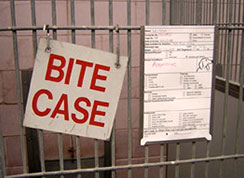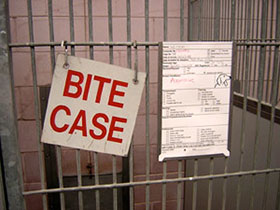

Photo by Dr. Miranda Spindel
The sign on this shelter kennel indicates the canine occupant has a history of biting. Shelter rules and practices vary on how such dogs are handled.
A man was mauled to death by a Rottweiler he'd adopted three hours earlier from the Jackson Madison Rabies Control shelter in Tennessee, local media reported last November. Anthony Riggs, 57, was said to be an experienced dog owner who had previously owned a Rottweiler, Doberman and wolf hybrid.
According to an account in The Jackson Sun, Riggs' wife found him dead at home. The dog bit her and a co-worker who accompanied her, then ran outside and was shot by deputies.
Neither the shelter nor its lawyer would discuss the case with the VIN News Service.
Riggs's death is an extreme demonstration of what can happen when shelters and rescue organizations adopt out an aggressive animal, whether knowingly or unintentionally.
Animal behaviorists familiar with practices in the shelter and rescue realm say the problem arises when animal-welfare organizations or public shelters fail to evaluate their charges for potential behavior issues before releasing them for adoption. Or, worse, they are so focused on increasing adoption rates and avoiding euthanasia that they rationalize that every animal deserves a chance, despite signs that an animal may be unstable.
"Frankly, I see this all the time. Either relinquishers don't tell the truth or the whole truth, or rescues put their own spin on things," Dr. Laurie Bergman, a behavior specialist in Pennsylvania, said on a message board of the Veterinary Information Network, an online community for the profession.
A board-certified veterinary behaviorist in private practice, Bergman said she's seen many instances in which unsuccessful adoptions were preceded by red flags, such as the animal having been in many different homes or being described as "not good with children" or "needs a quiet home." In her experience and estimation, such problems tend to originate with smaller rescue groups that look upon saving animals as a crusade.
"I know that this is unpopular in certain large corners of the sheltering world, but if the rescue doesn't have the ability to do really good pre-adoption work (e.g. , fostering, behavior modification, etc.) then dogs should not be adopted (which will probably mean euthanasia)," Bergman wrote.
Public shelters, too, can come under pressure to make more animals available for adoption, including those with questionable dispositions. Bergman, who previously worked as a behavior consultant, researcher and educator in California, recounted in an interview being told once by a municipal-shelter director in that state that the shelter could refuse to adopt out an animal only when prospective adopters had a record of animal-abuse charges. In other words, animals could be protected from dangerous people but not the reverse. The shelter also was allied with rescue and shelter support groups that pressed the agency to euthanize less.
"They were under competing pressures, so unless they could say an animal was a great risk, they felt like they had to make them available for adoption," Bergman said.
At the other end of the transaction are well-meaning adopters who have no idea what they're getting into. "The vast majority of adopters are not looking for projects, they're looking for pets," Bergman posted on VIN. "They're not prepared for what's involved with a pet with serious problems. Many of my clients, who are really committed to their pets, say straight out that knowing what they know [now], they wouldn't do it all over again."
Bergman told of a case in which a dog that she diagnosed with aggression while it was in foster care later was adopted by clients of hers. The rescue group had adopted out the dog with full knowledge of its behavior problems and without disclosing the problems to the adopters. The adoption and lack of disclosure went against Bergman's explicit written recommendation.
"The experience [my clients] had with the pet was bad, and the way they were treated by the rescue made it worse," Bergman told the VIN News Service. "The rescue had no consideration for the adopter or for what they were putting the people through — the risks, the emotions. The rescue took the attitude of ‘you're the bad guy.' "
That experience so disgusted Bergman that she stopped reaching out to work with rescues and shelters.
Aggressive pets present a danger not only to their households but to their veterinarians, as well.
One practitioner, for example, was bitten several times in the hand while examining a tumor on the paw of a border collie given to extreme anxiety. Its owner had adopted the dog two or three years earlier from a breed-rescue group. The dog had a history of aggression toward children, and had bitten both his owners, the practitioner said. The veterinarian, who remains a bit nervous around some border collies, asked not to be identified for fear of antagonizing the rescue group that arranged the adoption.
Kelley Bollen, an animal behavior consultant in Massachusetts, echoes Bergman's concerns. "I find that a lot of rescues are placing aggressive dogs these days," she said. "They are well-meaning people who love dogs, but they don't have any kind of background in behavior. I am becoming more and more frustrated with this field because people who are doing the right thing by adopting a shelter dog end up getting hurt, emotionally and physically. We should always strive to save as many animals as we can but we shouldn't put adopters or communities at risk."
In private practice, Bollen said, she sees numerous fearful, rescued dogs with significant behavior issues, including fear-based aggression due to lack of socialization.
"My consult today was someone who rescued a 7-year-old dog from Texas," Bollen said in a recent interview. "The dog is so fearful that after six weeks it still won't come out of the crate. Rescues feel sorry for these dogs, but they're totally unsocialized to humans; some have never been inside a house before. Someone [in the Northeast] will adopt a shy, fearful, under-socialized dog from the South because the rescue says all he needs is a family and love."
Bollen said such dogs can and do develop trust in their owners, but behavior issues may remain. "Once bonded, they then show aggression to strangers," she said.
Bollen, whose clients include shelters, said shelters don't maliciously seek to endanger anyone, of course. But good intentions to save lives may go too far.
"The no-kill movement has led to shelters believing that they should never euthanize, even though the original premise of the no-kill movement was to prevent the euthanasia of adoptable dogs," she said.
A 2001 article by Lynda Foro, a pioneer in the movement, suggests that saving animals at all costs was not an original principle of no-kill. The article states that no-kill caregivers and organizations "will put down dangerously aggressive animals that cannot be rehabilitated."
However, the No Kill Advocacy Center, which was founded in 2004, states in the position paper "No Dog Left Behind" that "it is not ethical to kill any animal for behavior reasons."
Asked to comment for this article, the center replied by email with a link to the paper, which argues that "the very nature of shelters themselves and the policies of those shelters undermine the mental health of dogs and set them up to fail. At the same time, the temperament tests used to evaluate those dogs are, at best, deeply flawed and thoroughly lack predictive validity."
One dedicated adherent of no-kill is Best Friends Animal Society, a nonprofit with the motto "Save Them All." Best Friends houses about 1,600 animals, mostly dogs and cats, at what it describes as the nation's largest no-kill sanctuary for companion animals, located in Kanab, Utah.
Holly Sizemore, chief national programs officer at Best Friends, told the VIN News Service by email, "We believe that every animal that can be saved should be saved." For animals with behavior problems, that means attempting rehabilitation with drugs or management, she said.
Management entails preventing an animal from encountering situations known to set it off. For example, if a dog is aggressive while eating, it is fed behind a closed door, away from others. If a dog is tense around children, it is kept away from children.
Sizemore said animals with extreme behavior problems require permanent placement at the sanctuary and live in a restricted area. Their caretakers wear protective equipment.
"While these animals may be limited in who they interact with, we focus on creating a positive living environment where they have individual enrichment plans in place," Sizemore said.
Bollen, speaking generally about sanctuaries, expressed doubts about inhabitants' quality of life. "There may be a few decent sanctuaries in this country, but many places that call themselves sanctuaries are no more than doggie prisons," she said. "No-kill shelters are chronic confinement for years. We couldn't have created a worse environment if we tried."
In fact, she said, long-term confinement in wire cages can turn what were fine dogs into aggressive dogs.
Aggression technically is a normal canine behavior and occurs on a spectrum, according to Dr. Miranda Spindel, a shelter-medicine specialist in Colorado. Some dogs are bred to be more aggressive, and some dogs' experiences shape their learning in that direction. Whether by genetics or environment, dogs with low thresholds at which they use significant aggression to deal with conflict — such as by biting rather than growling a warning — are dangerous, Spindel said. In most cases, when such dogs are in a shelter, she and Bollen maintain, euthanasia is the safest and most humane course.
This is because, they say, aggression cannot be fixed or cured.
Aggressive behavior can be modified, but the process is complex and often very difficult, requiring management for the animal's lifetime, Spindel said.
Bollen said: "The shelter environment is not conducive to the kind of consistent work needed to modify aggressive behavior. Additionally, when you are trying to modify aggressive responses, it is critically important that you do not allow the behavior to be triggered, and this is quite impossible in a shelter."
Outside of a shelter, Bollen tells clients she can help modify an animal's behavior by identifying what triggers its aggressive behavior and deploying management and positive counter-conditioning.
As explained by Spindel, a trigger could be someone getting near a dog's resource, a behaviorist's term for something or someone a dog values — a toy, a couch, food, a particular person and so on. Positive counter-conditioning is the act of gradually desensitizing the animal to someone being near its resource, such as by having a person approach to a distance that does not elicit the response, then very gradually coming closer. The dog is rewarded for responding without aggression.
Supposing a potential adopter is willing to work with a problematic dog, is there a way for the prospective owner to distinguish between an aggressive dog that can be worked with and one that can't?
Spindel says no.
"In my opinion, the average adopter does not have the ability to do this, and should not be expected to," she said. "Shelters and rescues should be adopting out behaviorally safe dogs."
Bollen said organizations that adopt out aggressive animals in the interest of saving lives actually risk doing the opposite. "Not only are they risking the safety of the public, they are putting every other shelter dog at risk of not being adopted as the public starts losing trust in shelters to provide them with a safe pet," she said.